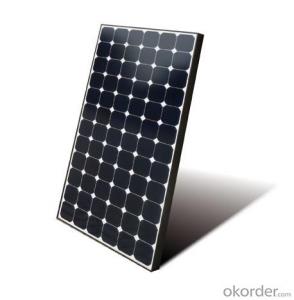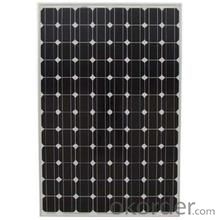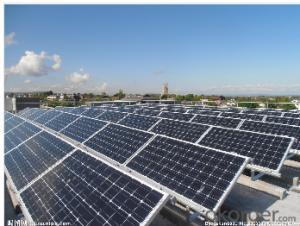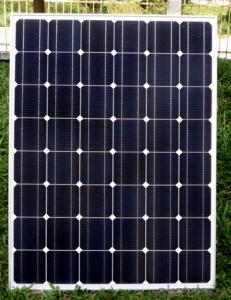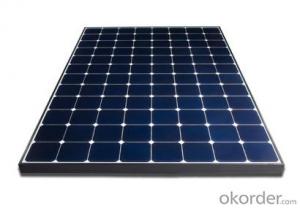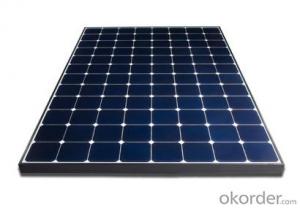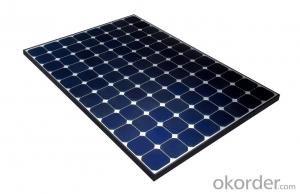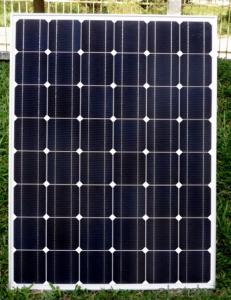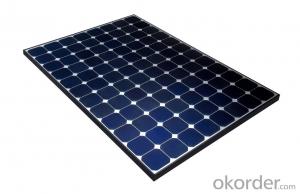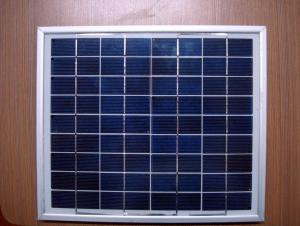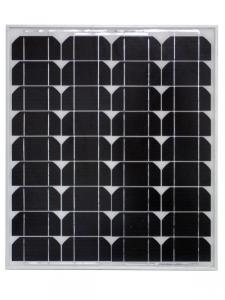Portable Solar Panels Kit - CNBM Mono Solar Panel 205W A Grade with Factory Price
- Loading Port:
- Shanghai
- Payment Terms:
- TT OR LC
- Min Order Qty:
- 100 watt
- Supply Capability:
- 100000 watt/month
OKorder Service Pledge
OKorder Financial Service
You Might Also Like
Specification
CNBM Moly Solar Panel 205W A Grade with Factory Price
Production description
A solar panel is a collection of solar cells. Lots of small solar cells spread over a large area can work together to provide enough power to be useful
The efficiency of a module determines the area of a module given the same rated output – an 8% efficient 230 watt module will have twice the area of a 16% efficient 230 watt module.
A solar cell, or photovoltaic cell, is an electrical device that converts the energy of light directly intoelectricity by the photovoltaic effect, which is a physical and chemical phenomenon.[1] It is a form of photoelectric cell, defined as a device whose electrical characteristics, such as current, voltage, or resistance, vary when exposed to light. Solar cells are the building blocks of photovoltaic modules, otherwise known as solar panels.
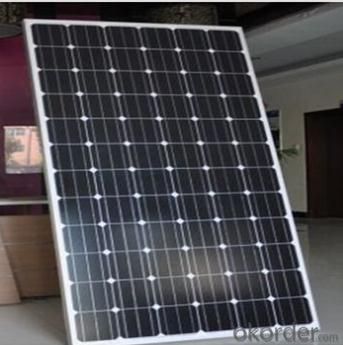
Application
Aerospace
Residential
Commercial
Large solar power plant
Distributed plant
Product Feature
1.A grade high efficiency solar cells.
2.TUV/UL/CE/CEC etc
3.Fast shippment
4.25 years warranty
5.OEM
Package
24pcs into one carton, 312pcs into a 20 foot container, 728pcs into a 40 foot container.
- Q: Well I was thinking about the idea of renovating either a smaller school bus or building a tiny house and I was wondering if i can get some information on the size and watts panel should I use or more like how to get that whole solar energy in motion. Any infor and links would help
- I think that typical solar panels are 2'x4' and produce something like 800-000 wh per day. (That's 0.8 - kwh per day.) More in the summer, less in the winter, if they're aimed sort of at the sun. There are newer, more expensive panels that produce more. There are also thin film panels that are less expensive, and probably more sturdy. You then have a couple choices. In a house, you'd have an expensive inverter to connect to the utility power, so you can have power at night when your panels aren't generating anything. In a trailer, you want 2-4-6 deep cycle car batteries to store the power. Then you could have an inverter to convert that power to 20v AC, so you could use normal appliances. Or, you could buy appliances that run on 2 volts DC. Maybe a combination of both. You'll need to figure out how much power you're going to use, so you know how many panels and batteries you're going to need. The calculation is easy. Figuring out how much power you need is hard. You need deep cycle batteries because you can repeatedly charge them way up and run them way down. Ordinary batteries die fairly quickly when you do that.
- Q: Can solar panels be used for powering electric lawnmowers or gardening tools?
- Yes, solar panels can be used to power electric lawnmowers or gardening tools. They can be connected to a battery system that stores the solar energy and then powers the electric equipment. This provides a sustainable and eco-friendly alternative to traditional power sources.
- Q: HIToday i was using my BB gun and shot my dads solar panel. I want to fix it for him because he spent a lot of time trying to get the solar panels. All i broke was the glass on the front, what is the glass and where can i buy new glass for it?
- Is it a solar water heater (with water running through it) or a solar electric panel (makes electricity)? If it is a solar water heater, you can buy tempered glass from a local glass dealer. If it is solar electric, it is probably cheaper to buy a new panel than trying to repair it. Read the label on the back of the panel to determine what model it is. If it is less than 40 watts, you may be able to have one shipped to you. If it is bigger than that, it will be expensive to ship just one panel, as it has to go by truck, you may be able to find a local place that sells them.
- Q: Someone Said It costed them 50,000 To Install Solar Panel In their House and 35,000 For Installation. Is that true?
- Are they saying that the panels cost $5k and the installation cost $35k? Or are they saying the panels were $50k, plus another $35k for installation, making the total $85k? Possibly the data was from several years ago. $5k buys 6 kW of panels today, larger than goes on most houses. Installation depends on local labor costs, but should not be more than about $5k in the US, unless the system is huge, or unusual, such as a standalone system on a concrete pad, instead of just on the roof. The system on our roof is roughly 3 kilowatts. If installed today, the parts would cost about $9k. After federal tax credit, $7k. Labor depends on the local situation. We installed our own, so didn't pay any labor cost.
- Q: Composition and function of solar panels
- In addition to the quality of EVA itself, the components of the manufacturers of laminated technology is also very large, such as EVA glue degree is not up to standard, EVA and tempered glass, backplane bonding strength is not enough, will cause EVA early aging, affecting components
- Q: Can solar panels be used to power outdoor lighting?
- Yes, solar panels can be used to power outdoor lighting. Solar panels convert sunlight into electricity, which can be stored in batteries or used directly to power outdoor lights, such as garden lights, streetlights, or security lights. This allows for sustainable and cost-effective lighting solutions in outdoor areas.
- Q: How do solar panels affect the insurance premiums of a home?
- Solar panels can potentially have a positive impact on home insurance premiums. While the initial installation cost of solar panels may increase the value of a home, they can also lower the risk of fire damage and reduce reliance on the grid. As a result, some insurance companies offer discounts or special policies for homes with solar panels, which may lead to lower insurance premiums in the long run. However, it is important to consult with individual insurance providers as policies can vary.
- Q: but is that per day, per hour or minute?How much watts does the average AC unit use?How much does an energy efficient lightbulb use?All in all let's hypothetically say we no longer use the electric company for our energy source, How many of these panels do you estimate it would take to supply our small home?
- Some great answers 23 max watts is per hour I live in an area that has 5.5 average sun hours per the solar insolation data which would give me a base of 676 watts produced per day for one panel. That 23 watts is most likely STC or standard test conditions which is far from standard it is ideal 70 degrees Farenheit with a 000 set flash PTC or physical test conditions are not always on labels and are not always accurate because of varied conditions. Heat has a huge factor on PV production. The panels should be derated by for the following reason ampacity correction or line loss Temperature correction PTC correction Inverter loss these corrections account for about 5 % on standard panels Our 676 watts per day has been dropped to 574 watts per day per panel Lets start with the light bulb. a standard 60 watt bulb uses 60 watts per hour. With the one panel we have chosen it would produce 5 hours and 45 minutes of illumination If we switch to a 5w CFL we get 38 and one half hours of illumination quite a difference yes Central Air will use about 2000 to 2500 watts per hour.This rule is not hard and fast as units will vary as well as conditions Lets use 2000 per hour times 8 hours of use is 6,000 watts we need 28 panels just for the ac. Probably another 28 for the rest of the house Of course these panel must be true south at 5 degrees mounted With a years worth of electric bills and a site visit I could come allot closer but lets say you need 60 of these panels this system would provide 973kHw per month at my location of 5.5 sun hours per day This would be a grid tied system as most state rebates require a grid tied system to qualify for rebates
- Q: Can solar panels be installed on a restaurant or food service establishment?
- Yes, solar panels can be installed on a restaurant or food service establishment. Many businesses in the food industry have successfully adopted solar energy systems to power their operations and reduce their electricity costs. Installing solar panels on rooftops or in parking lots can provide a sustainable and renewable energy source for the establishment, helping to lower its carbon footprint and contribute to a greener future.
- Q: i was reading the popular science magazine and i saw that they might make a Sun Powered it Absolutely NOT possible to make a car with a Solar Panel? I dont see any harm in making it..
- it's possible, but the oil company don't want you to, besides solar-powered cars need to be quite big to have those panels mounted on to provide the needed power, thus it'll take up alot of space on the road. they can't be as powerful as gas-powered cars in terms of speed hauling power. maybe they should make 2-seaters for city users, that'll cut down on the pollution ease up the gas prices. of course, they can make a hybrid car that uses an alternative power, like gas/solar or dry cell/solar to solve the problem... parking-meters with a power-plugs for you to recharge while you park.
Send your message to us
Portable Solar Panels Kit - CNBM Mono Solar Panel 205W A Grade with Factory Price
- Loading Port:
- Shanghai
- Payment Terms:
- TT OR LC
- Min Order Qty:
- 100 watt
- Supply Capability:
- 100000 watt/month
OKorder Service Pledge
OKorder Financial Service
Similar products
Hot products
Hot Searches
Related keywords
